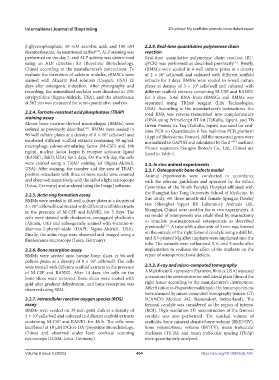Page 412 - IJB-9-5
P. 412
International Journal of Bioprinting 3D-printed Mg scaffolds promote bone defect repair
β-glycerophosphate, 50 mM ascorbic acid, and 100 nM 2.2.8. Real-time quantitative polymerase chain
dexamethasone. As mentioned earlier , ALP staining was reaction
[18]
performed on the day 7, and ALP activity was determined Real-time quantitative polymerase chain reaction (RT-
using an ALP detection kit (Beyotime Biotechnology, qPCR) was performed as described previously . Briefly,
[21]
China) according to the manufacturer’s instructions. To rBMSCs were seeded in 6-well culture plates at a density
evaluate the formation of calcium nodules, rBMSCs were of 2 × 10 cells/well and cultured with different scaffold
5
stained with Alizarin Red solution (Cyagen, USA) 21 extracts for 3 days. BMMs were seeded in 6-well culture
days after osteogenic induction. After photography and plates at density of 3 × 10 cells/well and cultured with
5
recording, the mineralized nodules were dissolved in 10% different scaffold extracts containing M-CSF and RANKL
cetylpyridine (Sigma-Aldrich, USA), and the absorbance for 3 days. Total RNA from rBMSCs and BMMs was
at 562 nm was measured for semi-quantitative analysis. separated using TRIzol reagent (Life Technologies,
USA). According to the manufacturer’s instructions, the
2.2.4. Tartrate-resistant acid phosphatase (TRAP) total RNA was reverse-transcribed into complementary
staining assay cDNA using PrimeScript RT kit (TaKaRa, Japan), and TB
Mouse bone marrow-derived macrophages (BMMs) were Green Premix Ex Taq (TaKaRa, Japan) was used for real-
isolated as previously described . BMMs were seeded in time PCR on QuantStudio 6 flex real-time PCR platform
[20]
96-well culture plates at a density of 8 × 10 cells/well and (Applied Biosystems, France). All the measured genes were
3
incubated different scaffold extracts containing 30 ng/mL normalized to GAPDH and calculated by the 2 -ΔΔCt method.
macrophage colony-stimulating factor (M-CSF) and 100 Primer sequences (Sangon Biotech Co., Ltd., China) are
ng/mL nuclear factor kappa B receptor activator ligand listed in Table 1.
(RANKL; R&D, USA) for 5 days. On the 5th day, the cells
were stained using a TRAP staining kit (Sigma-Aldrich, 2.3. In vivo animal experiments
USA). After staining, the number and the area of TRAP- 2.3.1. Osteoporotic bone defects model
positive osteoclasts with three or more nuclei were counted Animal experiments were conducted in accordance
and observed, respectively, with the aid of a light microscope with the relevant guidelines and approved by the Ethics
(Leica, Germany) and analyzed using the ImageJ software. Committee of the Ninth People’s Hospital affiliated with
2.2.5. Actin ring formation assay the Shanghai Jiao Tong University School of Medicine. In
BMMs were seeded in 48-well culture plates at a density of this study, 60 three-month-old female Sprague-Dawley
2 × 10 cells/well and treated with different scaffold extracts rats (Shanghai Sipper BK Laboratory Animals Ltd.,
4
in the presence of M-CSF and RANKL for 5 days. The Shanghai, China) were used for the in vivo experiments. A
cells were stained with rhodamine-conjugated phalloidin rat model of osteoporosis was established by ovariectomy
(Abcam, UK) and subsequently stained with 4-amino-6- to simulate postmenopausal osteoporosis as described
[18]
diamino-2-phenylindole (DAPI; Sigma-Aldrich, USA). previously . A tube with a diameter of 3 mm was formed
Finally, the actin rings were observed and imaged using a on the outside of the right femoral condyle using a drill bit,
fluorescence microscope (Leica, Germany). and 3D-printed Mg alloy implants were implanted into the
tube. The animals were euthanized 3, 6, and 9 weeks after
2.2.6. Bone resorption assay implantation to evaluate the effect of the implants on the
BMMs were seeded onto bovine bone slices in 96-well repair of osteoporotic bone defects.
culture plates at a density of 8 × 10 cells/well. The cells
3
were treated with different scaffold extracts in the presence 2.3.2. X-ray and micro-computed tomography
of M-CSF and RANKL. After 14 days, the cells on the A Multifocus X-ray system (Faxitron, Biotics, USA) was used
bone slices were removed. Bone slices were coated with to examine the anteroposterior and lateral plain films of the
gold after gradient dehydration, and bone resorption was right femur according to the manufacturer’s instructions.
observed using SEM. After fixation in 4% paraformaldehyde, the femur specimens
were scanned by micro-computed tomography (micro-CT;
2.2.7. Intracellular reactive oxygen species (ROS) SCANCO Medical AG, Bassersdorf, Switzerland). The
assay femoral condyle was considered as the region of interest
BMMs were seeded on 35-mm petri dish at a density of (ROI). High-resolution 3D reconstruction of the femoral
3 × 10 cells/well and cultured in different scaffold extracts condyle was also performed. The residual volume of
5
containing M-CSF and RANKL for 48 h. The cells were scaffolds, bone mineral density/bone volume (BMD/BV),
incubated at 10 μM DCFH-DA (Beyotime Biotechnology, bone volume/tissue volume (BV/TV), mean trabecular
China) and observed under laser confocal scanning thickness (Tb.Th), and mean trabecular spacing (Tb.Sp)
microscope (LCSM, Leica, Germany). were quantitatively analyzed.
Volume 9 Issue 5 (2023) 404 https://doi.org/10.18063/ijb.769

